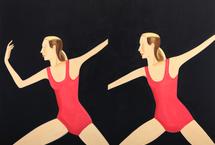We are proud to present for the first time in Madrid an exhibition dedicated to the cartoons of the American artist Alex Katz (b. New York, 1927). The monumental cartoons that serve as preparatory sketches for his paintings have been shown on a few occasions, starting at the Albertina Museum in Vienna in 2005. The exhibition that our gallery mounted in the spring of 2014, showing Katz’s Red Hat series, highlighted four stages of the painter’s working process: studies in oil on board, charcoal drawings, cartoons to transfer the composition onto the canvas’s surface before applying the colours, and the finished paintings. Cartoons presents a survey of Katz’s career in the last five decades through masterful examples of the drawings that the artist used in the creation of such emblematic paintings as Eleuthera (1984), Big Red Smile (1993–94), Visor (2003) and Bathing Cap Ada (2010).
Alex Katz is recognized as one of the most important artists in America today, but his work did not gain international exposure until the 1970s, and his influence has made itself felt since the end of the 1980s. Starting from the “all-over painting” of Abstract Expressionism, he followed an idiosyncratic course towards figurative painting before the rise of Minimalism and Pop Art. Katz uses a large-scale, iconic approach to portray aspects of New York’s artistic and cultural scene, the life of its comfortable classes, and the leisure and consumer society of his time. Drawing is an integral part of his working method, allowing him to observe light, adjust his design, balance the composition, establish an appropriate scale and create a state of mind, to achieve the cool aesthetic of the present moment in his paintings.
The term “cartoon” derives from the Italian cartone, referring to a type of rigid paper often used to transfer the main outlines of a composition to a blank canvas by means of pricking the lines and then “pouncing” or dabbing coloured powder through the pin-pricks. Katz is one of the few contemporary painters still using what is essentially a Renaissance technique to create his pictures. In the cartoons we can enjoy the natural appeal of a product that is inherently utilitarian but which we can also see to possess an uninhibited grace and elegance without pretensions. Comprehending form and structure through the final confirmation of the profile, shading, proportion brings it to a complete integraton of the painted and drawn elements in the finished works, carried through in a single, intense impulse.
These drawings, with their perforated contours, are wonderful witnesses to their single function as working tools. Each cartoon establishes the basic lines of the composition before they are transferred to a canvas of the same size and transformed into the dazzling colours that characterise Katz’s painting. Although the cartoon is a preliminary template, part of the process in the creation of a painting, Katz sees them as finished documents with their own artistic meaning: portraits structured in two dimensions related to effects of light and volume, compositions where the technique forces him to refine to a few details and surfaces, where the resonance of the paper’s empty space is comparable to the monochromatic areas of his paintings, as we can see in the recent canvases included in the exhibition.
Katz attributes much of his process in painting to instinct, but this spontaneity does not preclude meticulous planning of his work. Its two-dimensionality and schematized design, its distancing and subtle simplicity are fully developed in the contours of his drawings and cartoons with their distinctive overlays, parallel lines and corrections that are left behind in his search for the perfect form. These cartoons, though never created to be exhibited, produce a stange artistic effect on account of the chalk dust that is pounced on the charcoal, and the blurred image that results has an unexpected and striking beauty. The liveliness of the underlying expressive line is retained, minimized and perfected through the various transfer techniques into the gestural style of the paintings.
Text: Jimena López
Download as PDF (165 K)